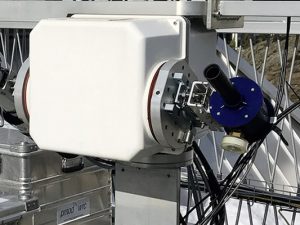SEKTION OZON
Ozon-Messreihe aus Arosa/Davos
Die “Total Column Ozone” (TCO) -Zeitreihe aus Arosa/Davos stellt den längsten kontinuierlichen Datensatz der Welt dar und beginnt im Jahr 1926. Sie besteht aus Messungen von drei . . .
INFO3RS / KOHERENT
Das Projekt INFO3RS zielt darauf ab, die zukünftige Entwicklung von “Total Column Ozone” (TCO) in der Schweiz zu untersuchen. Als Ergänzung zu den vorhandenen Messungen . . .
INFO3RS / CCM-SOCOL
Das Projekt INFO3RS zielt darauf ab, die zukünftige Entwicklung von “Total Column Ozone” (TCO) in der Schweiz zu untersuchen. Um die Trendanalyse der Entwicklung der Ozonschicht . . .
Internationale Ozon-Vergleiche
In August 2022 fand am PMOD/WRC der XVII Regional Brewer Calibration Center for Europe (RBCC-E) Vergleich statt. MeteoSchweiz und das Global Atmosphere Watch . . .
The Arosa/Davos total ozone column measurement series represent the World’s longest continuous time-series, starting in 1926. It is composed of measurements from three Dobsons and at a later stage from three Brewer spectrophotometers. The observation of an eventual recovery of the ozone layer requires uninterrupted measurements of the highest quality, spanning several decades, and extending the current dataset to at least the middle of the 21st century. This long-term vision currently relies on instruments developed in the 1920s (Dobsons) and 1980s (Brewers), whose remaining lifetime is uncertain.
The INFO3RS GAW-CH project (“Investigating the Future Evolution of the Ozone Layer above Switzerland”) examines the recovery of the stratospheric ozone layer by means of direct radiation measurements in Davos, Arosa and global climate models. This project will assess the capabilities of state-of-the-art spectroradiometer systems to complement and eventually replace this ageing instrumentation.
The revision of the ozone time-series with state-of-the art methods and datasets and the overall uncertainty budget of the entire time-series for all intruments is important to evaluate the significance of any possible trend. This will be supported by determining the evolution of future total column ozone concentrations over Switzerland, and will be simulated with a state-of-the-art chemistry climate model (CCM-SOCOL) for various scenarios. The time when an unequivocal observation of ozone recovery can be expected will be obtained by combining the data-set analysis, the corresponding observational uncertainties and the model calculations.




